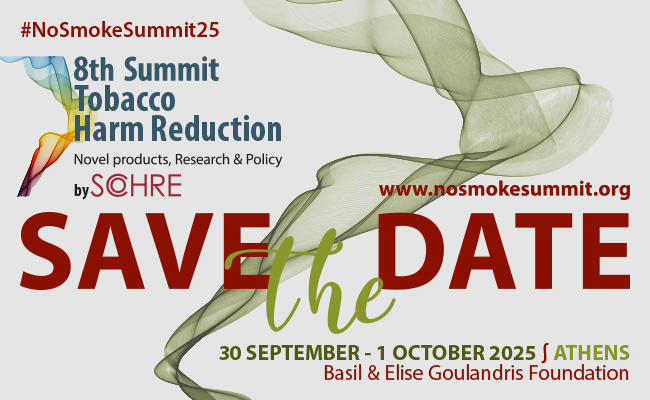Professor Andrzej Fal, a distinguished expert in public health and tobacco harm reduction, delivered a highly inspiring keynote speech focused on the economic implications of lifestyle choices and the important role of financial tools in promoting healthier behaviors. Professor Evanthia Sakellari moderated this session.
Emphasizing to the significant economic burden of non-communicable diseases (NCDs), the speaker advocated for the need to address modifiable behavioral risk factors, and presented compelling data on the potential returns of investing in health prevention initiatives, illustrating how promoting healthy habits could lead to substantial financial savings and improved quality of life.
The number of people living worldwide is increasing, Professor Andrzej Fal stated, although there are apparent differences between continents, since the population seems to remain stable in Asia and still increase in Africa while decreasing in Europe, Northern Africa and South America. The reason for that, he explained, is that the risk factors of premature deaths or risk factors of chronic disease development have changed dramatically in the past 50-70 years. Speaking about Europe and North America, the risk factors have completely changed, he said, and among the leading factors of chronic diseases nowadays are tobacco smoking, physical inactivity and junk food consumption resulting in overweight, and outdoor air pollution.
Tobacco, indoor, but mostly outdoor air pollution, bad diet, and alcohol use are responsible for over 20 million premature deaths all over the world, with 17 million deaths attributable to cardiovascular diseases. Cardiovascular diseases are the leading cause of premature deaths and, along with cancers, are mainly caused by tobacco smoking and the outdoor air pollution. Based on what we’ve learned about the risk factors and the diseases in the past 50-70 years, WHO suggested the 5 x 5 approach, which includes 5 major risk factors and 5 major groups of diseases responsible for the shortening of life and the decreased quality of life, and partially responsible also for the decrease of population, especially in continents like Europe and North America. The main outcomes of non-communicable chronic diseases (NCDs), from a point of view of an economist, are that they influence the labor, and they are limiting the capital a person has and can invest.
In wealthier countries, NCDs are responsible for over 90% of all premature deaths, also, in the same group of countries, they are responsible for at least 70% of lost financial output. So, our lifestyle is not only destroying our health but results also in financial losses and the lower development or lower prosperity of the economic system that we are all part of. Investing on prevention and change of unhealthy behaviors, from cigarette smoking to unhealthy diet, alcohol drinking, physical inactivity and so on, can earn us not only life years and improved quality of life but also money.
Every successful smoking cessation attempt decreases the risk of NCDs, and preventing NCDs builds up the savings. In fact, it is estimated that when we invest 1 dollar for smoking cessation, we can expect 7.5 dollars saving in the healthcare system after 15 years, Professor Fal explained. The economic loss of cigarette smoking is about 2%, 1.8% of GDP in the global perspective. It’s a huge price, but of course, much bigger price is the lives lost.
Of course, we can’t persuade everyone to quit smoking, drinking, and eat an unhealthy diet, but we can affect some people, and at least convince others to switch to less risk or modified risk products, the speaker said.
We have replacement products in the market, for every single unhealthy behavior, which will not be as effective for health as total cessation, but still will be better than continuing the ongoing habit.
Speaking about the disparities in health investment for prevention and prophylaxis, Andrzej Fal highlighted the wide variation between countries such as Canada, Latvia, Greece, Norway, and Poland. He underscored the direct correlation between investment in public health and the prevalence of risk factors, particularly in smoking and dietary risks, and emphasized the long-term payoff of investing in prevention for public health.
Investment in prevention differs very between countries, he said. Leading Canada spends almost $300 per year per person for prevention, while Latvia and Greece spend around $30—which is tenfold less. Comparing the outcomes of investing on health promotion and prophylaxis between Norway and Poland, Professor Fal pointed out that because Poland spends very little for public health and prevention, every single risk factor responsible for the development of NCDs—and therefore for the future losses in economics—is much more present in Poland than in Norway. This is a pure effect of the money spent on prophylaxis prevention and health education, he concluded.
Tobacco use and cigarette smoking is an exceptional risk factor, Professor said, not only because it kills over 8 million people a year all around the globe, but because it also affects and kills non-smokers, since amongst those 8 million dying from cigarette-related diseases, 1 million are second-hand smokers.
Cigarette smoking in Poland is responsible for over 550,000 life-years lost, Professor Fal said. Of course, quitting is the most effective way to impact a healthy lifestyle, he added, but we also have to offer to those who are not willing, or for some reason cannot quit, the opportunity to change to less harmful nicotine delivering methods.
Due to addictive nature of some factors in smoking, drinking, sugar eating, giving up these bad habits is difficult or even sometimes impossible. Hence, at this point, harm reduction techniques play a role. However, we need to finally prove the effectiveness of some of them to stop the discussions which are only wasting time. Investing in the prevention and eradication of risk factors is the most viable program from economic, health, or social perspective.
Discussion
Professor Fal replied to questions from the audience regarding successful tobacco harm reduction policies and the European Commission’s new plan to encourage countries to prohibit smoking and vaping in public spaces.
There are several countries who have found their own way in fighting cigarette smoking, Professor Fal said. Sweden, for example, is the first country which is very close to what we can call according to the WHO standards “a smokeless country.” These countries have developed their own health policies, and these policies are quite far away from those suggested 25 years ago by WHO. “I’m not an international politician, so I cannot influence this directly, Professor Fal said, but I’m supporting the thesis that we need finally to have proofs of harm reduction.” THR can be a very valuable tool, since even though 60% of smokers declare that they want to quit, only 15% of them succeed after three years. Another very important policy, which has been implemented by New Zealand, Malaysia, England, and Sweden, is the introduction of one-hour classes about public health at schools. During this hour, he noted, children are being taught what public health and a healthy lifestyle are, and how to behave “wise, healthy, and wealthy.” “First, you have to be wise, then healthy, and then you can become wealthy,” Professor Fal explained. Let’s hope that other countries will soon follow this path.”
Regarding the European Commission’s new plan to encourage countries to prohibit smoking and vaping in public spaces, Professor Fal commented that when a person is hospitalized because they are sick with any of the NCDs resulting from a bad lifestyle, this is a very good time to quit the bad habit and start a new life. Therefore, he added, all the medical facilities like hospitals or outpatient departments should be absolutely free of any kind of smoking device because we are all aware that even harm reducing techniques are also a little harmful.



